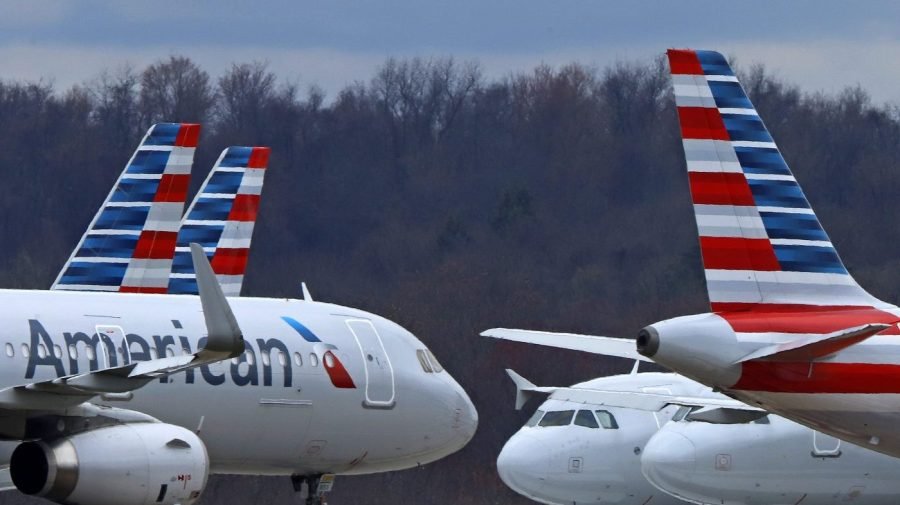Business
Thanksgiving shutdown sets up nightmare scenario for travels on November 13, 2023 at 11:00 am Business News | The Hill

The government is days away from a Nov. 18 shutdown, which could force Transportation Security Administration (TSA) employees and federal air traffic controllers to work without pay just as the busy Thanksgiving travel season begins.
AAA, which is set to release its 2023 Thanksgiving Holiday Travel Forecast on Monday, estimated 4.5 million Americans would fly to their Thanksgiving destination over the five-day period surrounding the holiday last year.
These are the busiest travel days of the year, and could coincide with a government shutdown unless Congress comes together on a deal in the next few days. Absent some kind of new funding bill, the government would shut down on Saturday.
Travel industry officials and advocates are amping up their warnings, saying the nation risks a messy travel season if lawmakers are unable to reach a deal.
“We are quickly approaching what is forecasted to be the busiest travel period since before the pandemic; and it’s critical that policymakers work together to avoid a shutdown and support continued, safe, and efficient airport operations,” Kevin M. Burke, president and CEO of the Airports Council International-North America (ACI-NA), told The Hill.
More than 50,000 TSA officers and 13,000 Federal Aviation Administration (FAA) air traffic controllers would continue to work without pay until the government is funded.
The TSA workers are among the lowest paid in the government, however, and during the last shutdown, in 2019, large numbers called in sick weeks into the a shutdown where they’d miss pay. That pressure was credited in part with ending that standoff in Congress.
TSA workers are expected to get their next paycheck just as the shutdown begins, which could alleviate some stress in the near term over Thanksgiving, at least.
The Biden administration warned ahead of the last near-shutdown at the end of September that it could delays and longer wait times at America’s airports.
“Previous shutdowns have affected every function of aviation and air travel and have specifically harmed regional airports and put a strain on air traffic controllers nationwide,” Sen. Jerry Moran (R-Kan.), co-chair of Travel Caucus and ranking member of the Commerce Aviation Subcommittee, told The Hill.
Here’s how a shutdown could affect the nation’s airports.
Longer screening times
Airports and TSA are getting busier and busier since the end of the coronavirus pandemic.
The TSA screens on average 2.5 million passengers each day, a figure that surpasses pre-pandemic travel totals.
While TSA will have airports staffed for the Thanksgiving season regardless of whether there’s a shutdown, it’s possible the number of workers showing up to screen travelers will fall the longer they are going without pay.
“Because fewer workers are on the job during a shutdown, TSA security lines could be longer or there could be flight delays due to fewer air traffic controllers. If you’re flying during a shutdown, arrive at the airport extra early,” Paula Twidale, senior vice president of AAA Travel, told The Hill.
The Denver International Airport, ranked the third busiest airport in North America for passenger travel in 2022 by the ACI-NA, estimates around 500,000 passengers will pass through TSA checkpoints between Nov. 18 and 25, said Stephanie Figueroa, a public information officer at the Denver airport.
While Figueroa stressed it’s still too far out to have firm figures, she said the airport relies on federal agency partners including the capacity of TSA officers and air traffic controllers to keep those passengers moving smoothly.
“The prior shutdown did result in traveler frustration, with passengers forced to endure increased wait times and travel delays at many airports, especially as the shutdown continued for an extended time,” Figueroa said.
Personnel “will do their best to meet wait time standards of 10 minutes and under for TSA PreCheck lanes and 30 minutes and under for standard screening lanes at security checkpoints,” a TSA spokesperson told The Hill.
“An extended shutdown could mean longer wait times at airports.”
The last government shutdown spanned 35 days from Dec. 22, 2018, through Jan. 25, 2019, and was the longest in American history.
During the shutdown, the national rate of airport screener absences more than tripled from 3 to 10 percent, according to a September 2023 analysis by Tourism Economics.
TSA officer call-outs increased by 200 to 300 percent at the Dallas-Fort Worth International Airport, ranked the second busiest airport for North American passenger travel by AIC-NA in 2022, the analysis found.
“It’s very hard for anybody to go for 20 days, 30 days, 40 days or longer without receiving a paycheck. It impacts the ability of people to get to work, to pay to put gas in their vehicles, to pay for parking. It impacts their ability to pay the individuals that provide care for their children,” the TSA spokesperson said.
Delays and cancellations
Once passengers make it past security, air traffic controller shortages mean more flights may get delayed or canceled.
The U.S. is already experiencing a shortage of air traffic controllers, in part due to a training backlog created by COVID. To close the gap, the FAA said it has hired 1,500 controllers this year and plans to hire an additional 1,800 next year.
A government shutdown would pause hiring, training and technology upgrades. Certain “safety-critical” workers including air traffic controllers, technicians and safety inspectors would keep working, although they wouldn’t be paid until the government reopens.
“Even though the FAA would carry out its mission, a government shutdown would set the agency back on critical efforts,” an FAA spokesperson told The Hill. “Even a shutdown for a week would set the agency back a month.”
With air traffic controller ranks already down, it could take longer for flights to get off the ground — if they do at all — if those employees start calling out.
Flight cancellations ticked up to 2.86 percent in January 2019 from 1.14 percent in December 2018 and 1.07 in the preceding month, according to Bureau of Transportation Statistics data. The percentage of outbound delayed flights was actually below the annual average for both years.
“Critical functions at the FAA can be suspended during a shutdown, causing significant issues for aircraft manufacturers and regional airports, and – importantly – passengers needing to get to their next destination quickly and safely,” Moran said.
The economic impact
Travel advocates urged lawmakers to avoid hamstringing the industry during the busy holiday season.
“Travelers, especially heading into a peak travel season, need certainty that operations will continue without the interruption or added hassles that a government shutdown could surely create,” Tori Emerson Barnes, executive vice president of public affairs and policy at the U.S. Travel Association, told The Hill.
“A completely avoidable shutdown threatens a steep economic toll on the U.S. travel economy,” Barnes added.
Overall, a shutdown could cost the travel industry and broader economy as much as $140 million per day, according to the Tourism Economics analysis. That forecast includes declines in air, rail and government-related business travel and the closure of attractions including National Parks and museums.
Around $36 billion of that total would hit the air travel industry each day.
“Commercial aviation plays a vital role in the American economy, supporting 5% of the U.S. GDP and more than 10 million jobs. Failure to adequately fund the FAA and TSA risks our ability to function efficiently and is not conducive to the growth and vitality of our airspace,” Marli Collier, a spokesperson for Airlines for America, told The Hill.
Business, Policy, Transportation, FAA, flights, Jerry Moran, Joe Biden, Pete Buttigieg, Thanksgiving, travel, TSA The government is days away from a Nov. 18 shutdown, which could force Transportation Security Administration (TSA) employees and federal air traffic controllers to work without pay just as the busy Thanksgiving travel season begins. AAA, which is set to release its 2023 Thanksgiving Holiday Travel Forecast on Monday, estimated 4.5 million Americans would fly to…
Business
Why 9 Million Americans Have Left

The Growing American Exodus
Nearly 9 million Americans now live outside the United States—a number that rivals the population of several states and signals a profound shift in how people view the American dream. This mass migration isn’t confined to retirees or the wealthy. Thanks to remote work, digital nomad visas, and mounting pressures at home, young professionals, families, and business owners are increasingly joining the ranks of expats.

Rising Costs and Shrinking Wallets
Living in the US has become increasingly expensive. Weekly grocery bills topping $300 are not uncommon, and everyday items like coffee and beef have surged in price over the last year. Rent, utilities, and other essentials also continue to climb, leaving many Americans to cut meals or put off purchases just to make ends meet. In contrast, life in countries like Mexico or Costa Rica often costs just 50–60% of what it does in the US—without sacrificing comfort or quality.
Health Care Concerns Drive Migration
America’s health care system is a major trigger for relocation. Despite the fact that the US spends more per person on health care than any other country, millions struggle to access affordable treatment. Over half of Americans admit to delaying medical care due to cost, with households earning below $40,000 seeing this rate jump to 63%. Many expats point to countries such as Spain or Thailand, where health care is both affordable and accessible, as a major draw.

Seeking Safety Abroad
Public safety issues—especially violent crime and gun-related incidents—have made many Americans feel unsafe, even in their own communities. The 2024 Global Peace Index documents a decline in North America’s safety ratings, while families in major cities often prioritize teaching their children to avoid gun violence over simple street safety. In many overseas destinations, newly arrived American families report a significant improvement in their sense of security and peace of mind.
Tax Burdens and Bureaucracy
US tax laws extend abroad, requiring expats to file annual returns and comply with complicated rules through acts such as FATCA. For some, the burden of global tax compliance is so great that thousands relinquish their US citizenship each year simply to escape the paperwork and scrutiny.
The Digital Nomad Revolution
Remote work has unlocked new pathways for Americans. Over a quarter of all paid workdays in the US are now fully remote, and more than 40 countries offer digital nomad visas for foreign professionals. Many Americans are leveraging this opportunity to maintain their US incomes while cutting costs and upgrading their quality of life abroad.

Conclusion: Redefining the Dream
The mass departure of nearly 9 million Americans reveals deep cracks in what was once considered the land of opportunity. Escalating costs, inaccessible healthcare, safety concerns, and relentless bureaucracy have spurred a global search for better options. For millions, the modern American dream is no longer tied to a white-picket fence, but found in newfound freedom beyond America’s borders.
Business
Will Theaters Crush Streaming in Hollywood’s Next Act?

Hollywood is bracing for a pivotal comeback, and for movie lovers, it’s the kind of shake-up that could redefine the very culture of cinema. With the freshly merged Paramount-Skydance shaking up its strategy, CEO David Ellison’s announcement doesn’t just signal a change—it reignites the passion for moviegoing that built the magic of Hollywood in the first place.

Theatrical Experience Roars Back
Fans and insiders alike have felt the itch for more event movies. For years, streaming promised endless options, but fragmented attention left many longing for communal spectacle. Now, with Paramount-Skydance tripling its film output for the big screen, it’s clear: studio leaders believe there’s no substitute for the lights, the hush before the opening credits, and the collective thrill of reacting to Hollywood’s latest blockbusters. Ellison’s pivot away from streaming exclusives taps deep into what unites cinephiles—the lived experience of cinema as art and event, not just content.
Industry Pulse: From Crisis to Renaissance
On the financial front, the numbers are as electrifying as any plot twist. After years of doubt, the box office is roaring. AMC, the world’s largest theater chain, reports a staggering 26% spike in moviegoer attendance and 36% revenue growth in Q2 2025. That kind of momentum hasn’t been seen since the heyday of summer tentpoles—and it’s not just about more tickets sold. AMC’s strategy—premium screens, with IMAX and Dolby Cinema, curated concessions, and branded collectibles—has turned every new release into an event, driving per-customer profits up nearly 50% compared to pre-pandemic norms.
Blockbusters Lead the Culture
Forget the gloom of endless streaming drops; when films like Top Gun: Maverick, Mission: Impossible, Minecraft, and surprise hits like Weapons and Freakier Friday draw crowds, the industry—and movie fans—sit up and take notice. Movie-themed collectibles and concession innovations, from Barbie’s iconic pink car popcorn holders to anniversary tie-ins, have made each screening a moment worth remembering, blending nostalgia and discovery. The focus: high-impact, shared audience experiences that streaming can’t replicate.
Streaming’s Limits and Studio Strategy
Yes, streaming is still surging, but the tide may be turning. The biggest franchises, and the biggest cultural events, happen when audiences come together for a theatrical release. Paramount-Skydance’s shift signals to rivals that premium storytelling and box office spectacle are again at the center of Hollywood value creation. The result is not just higher profits for exhibitors like AMC, but a rebirth of movie-going as the ultimate destination for fans hungry for connection and cinematic adventure.

Future Forecast: Culture, Community, and Blockbuster Dreams
As PwC and others warn that box office totals may take years to fully catch up, movie lovers and industry leaders alike are betting that exclusive theatrical runs, enhanced viewing experiences, and fan-driven engagement are the ingredients for long-term recovery—and a new golden age. The Paramount-Skydance play is more than a business move; it’s a rallying cry for the art of the theatrical event. Expect more big bets, more surprises, and—finally—a long-overdue renaissance for the silver screen.
For those who believe in the power of cinema, it’s a thrilling second act—and the best seat in the house might be front and center once again.
Business
Why Are Influencers Getting $7K to Post About Israel?

Influencers are being paid as much as $7,000 per post by the Israeli government as part of an expansive and sophisticated digital propaganda campaign. This effort is designed to influence global public opinion—especially among younger social media users—about Israel’s actions in Gaza and to counter critical narratives about the ongoing humanitarian situation.

How Much Is Being Spent?
Recent reports confirm that Israel has dedicated more than $40 million this year to social media and digital influence campaigns, targeting popular platforms such as TikTok, YouTube, and Instagram. In addition to direct influencer payments, Israel is investing tens of millions more in paid ads, search engine placements, and contracts with major tech companies like Google and Meta to push pro-Israel content and challenge critical coverage of issues like the famine in Gaza.
What’s the Strategy?
- Influencer Contracts: Influencers are recruited—often with all-expenses-paid trips to Israel, highly managed experiences, and direct payments—to post content that improves Israel’s image.
- Ad Campaigns: State-backed ad buys show lively Gaza markets and restaurants to counter global reports of famine and humanitarian crisis.
- Narrative Management: These posts and ads often avoid overt propaganda. Instead, they use personal stories, emotional appeals, and “behind the scenes” glimpses intended to humanize Israel’s side of the conflict and create doubt about reports by the UN and humanitarian agencies.
- Amplification: Paid content is strategically promoted so it dominates news feeds and is picked up by news aggregators, Wikipedia editors, and even AI systems that rely on “trusted” digital sources.
Why Is This Happening Now?
The humanitarian situation in Gaza has generated increasing international criticism, especially after the UN classified parts of Gaza as experiencing famine. In this environment, digital public relations has become a primary front in Israel’s efforts to defend its policies and limit diplomatic fallout. By investing in social media influencers, Israel is adapting old-school propaganda strategies (“Hasbara”) to the era of algorithms and youth-driven content.
Why Does It Matter?
This campaign represents a major blurring of the lines between paid promotion, journalism, and activism. When governments pay high-profile influencers to shape social media narratives, it becomes harder for audiences—especially young people—to distinguish between authentic perspectives and sponsored messaging.

In short: Influencers are getting $7,000 per post because Israel is prioritizing social media as a battleground for public opinion, investing millions in shaping what global audiences see, hear, and believe about Gaza and the conflict.

 Business3 weeks ago
Business3 weeks agoDisney Loses $3.87 Billion as Subscription Cancellations Surge After Kimmel Suspension

 Entertainment3 weeks ago
Entertainment3 weeks agoWhat the Deletion Frenzy Reveals in the David and Celeste Tragedy

 Entertainment4 weeks ago
Entertainment4 weeks agoABC Suspends ‘Jimmy Kimmel Live!’ Indefinitely After Kirk Remarks

 Entertainment3 weeks ago
Entertainment3 weeks agoExecutive Producer Debut: How Celia Carver Created Festival Hit ‘Afterparty’

 Film Industry4 weeks ago
Film Industry4 weeks agoCan Movie Theaters Steal the Show from Streaming?

 Health3 weeks ago
Health3 weeks agoRussia Claims 100% Success With New mRNA Cancer Vaccine

 News4 weeks ago
News4 weeks agoBody of Missing Teen Found in Tesla Linked to Musician D4vd

 Business4 weeks ago
Business4 weeks agoWhy Small Theaters Are Thriving While the Industry Struggles




























